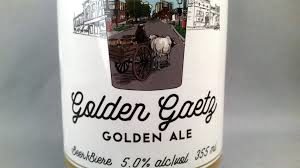So lots of breweries engage in hop experiments – swapping out varieties of hops to experience the flavour effect. Most breweries are not so fast to play around with their malt. Malt is the anchor for a beer. It lays down the core flavours that create a beer’s character.
I don’t want to exaggerate. Some breweries have played around with single malt beer to isolate malt flavours. It is just that particular practice hasn’t caught on the way single hopping has. I think because the flavour effects of hops are so in-your-face, like a crazy guitar solo, while malt is more like a solid bass line, laying down an essential groove but in a way many don’t even notice it.
Why do I say all this?
Because Red Deer’s Troubled Monk decided to play around with malt to see what effects it has on beer. It took is Golden Gaetz Golden Ale, its light blonde ale, and made three versions using different malt and put them in a mixed six-pack. To tell it is a mixed pack, you have to read the labels carefully as from a quick glance it looks like their normal pack.
The beer is an excellent candidate for a malt experiment as it has a low hop regime and the malt bill is quite simple, just 90% 2-row base malt with 10% carapils. They held the carapils constant and swapped out the base malt. The first beer is their regular recipe, with 85% Copeland malt from Rahr Malting with 15% Synergy from new Alberta craft maltster Red Shed. That is their control. Beer two is made with 100% Synergy from Red Shed. The third beer is 100% Bentley, also from Red Shed.
I thought it would be cool to see if I could tell the difference between the three beer. Turns out the subtle packaging made it easy for me to blind the taste test. I covered the label, mixed up the cans and gave them each a number. I handled all beer the same, opened at the same time and poured them into identical glasses. I only revealed which each was after taking my notes.
I won’t keep you in suspense and will tell you there was a noticeable difference in colour, body, flavour and aroma across the three. The regular version poured slightly darker and had a more intense aroma, offering both a sharper grain and a bit more floral character. The Synergy beer had a bit of a haze to it and the aroma had more honey and a noted oatmeal cookie character. The Bentley had the softest aroma of the three, with a soft graininess.
I will re-produce the flavour notes verbatim as there is a degree of complexity in the comparisions.
Synergy: Gentle, soft sweetness of honey and light fruit at first. Malt character is strongest in the middle, rising to a soft earthy graininess. I pick up a toasted rice character. The finish is gentle with a grainy sharpness blending with hops, smooth, almost creamy body.
Control: Has a fuller sweetness than the other two upfront with a berry character and a sweet mead note as well. Less creamy than the others, but offers a fuller note reminding me more of a Czech pils malt base. Malt is more forward on this one, slowing dropping into a moderately sweet finish. Seems more “cooked” in a decoction kind of way. It is fuller and a bit sweeter.
Bentley: Has the softest texture of the three with muted honey and a soft grain sweetness. Sharpens up a bit more in the back end, leaving a grainy linger. Most neutral of the beer overall although the linger is the most pronounced, with an earthy hop/sharp grain mix.
The control beer was markedly different than the experiments, both darker and fuller. Even across many days I think I could tell it apart from the other two. However, the differences between the two experiments are present but subtle. If I tried each beer on different days, I am not sure I would identify the difference.
I found this a fascinating taste test. I can’t say I am surprised to have found such complex and nuanced differences between the beer, but the results still have me intrigued.
Brewers (myself included) sometimes take our base malt for granted, I think. Sure, we want high quality malt, but we spend most of our energy working with the specialty malts to bring out the flavours we want. This test demonstrates what a significant difference the base malt can make. Swapping out only the base malt produced measurable changes to colour, aroma, flavour, body and linger.
Don’t let anyone tell you that the bass player isn’t as important as the lead guitarist. And don’t let anyone tell you base malt doesn’t make a difference.


March 20, 2017 at 6:50 PM
Great article as usual and way over my knowledge base as far as brewing goes. Love their products and hope for more Experiments. They will do well. Here is an old tune from the 60’s just for the fun of it by the Beatles. Hope you don’t mind ? The bass player is as important as the lead guitarist. Thanks https://www.youtube.com/watch?v=MbQiVQuiu04